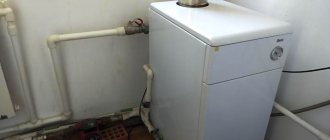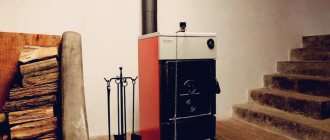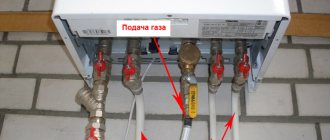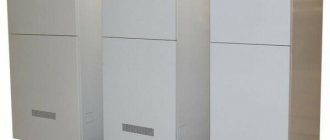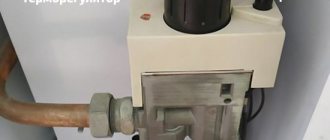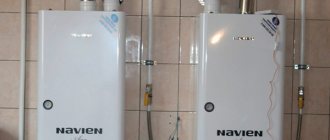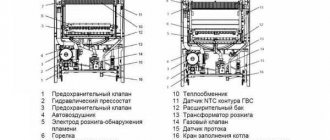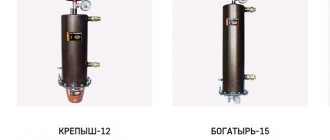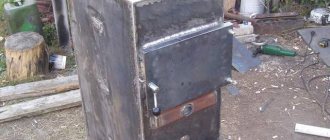Here you will learn:
- How do Stropuva boilers work?
- Main models
- How to start a Stropuva boiler
- Reservation of work
- Reviews from real owners
Traditional solid fuel boilers are not capable of providing long-term combustion of up to one or two days or more. And even impressive combustion chambers do not adequately solve this problem. Its solution will be the Stropuva boiler - equipment from a Lithuanian brand. The principle of surface combustion is used here, ensuring long-term operation from a single load of fuel.
In this review we will look at:
- Construction of Stropuwa boilers.
- The principle of their work.
- Technical characteristics of the equipment.
- Popular models.
At the end of the article, user reviews will be given.
Brief characteristics of STROPUVA boilers
The declared fuel for such boilers is any kind of solid fuel and, as manufacturers say, the efficiency of these boilers reaches 90% .
The innovative technology used in the design of the boilers allows them to work with one load of firewood for up to 30 hours, with special fuel briquettes for up to 48 hours, and with coal for up to 5 days.
The buyer can choose a boiler option based on power:
- 7 kW for areas from 20 to 80 m²;
- 10 kW for an area from 50 to 100 m²;
- 20kW for an area from 100 to 200m²;
- 40 kW for areas from 200 to 400 m².
As you can see, the choice is quite wide and the buyer can easily choose a small solid fuel for a utility room or a huge house, and even a workshop.
Reservation of work
The Stropuva boiler will delight you with long-lasting fuel combustion. But even in this case, you can miss the moment of the next bookmark. As a result, the temperature of the coolant in the heating circuit will begin to fall. To prevent this from happening, we recommend installing a backup electric boiler in the circuit. If it detects a temperature drop below the set limit, it will turn on and maintain the set temperature.
Electricity consumption will be small if you don’t forget to add firewood for 2-3 days. The vast majority of the time the boiler will burn, providing heat to consumers. Therefore, you should not expect huge expenses. In addition, the auxiliary boiler does not have to be as powerful as the main one - a model with a power 2-3 times lower is quite enough so as not to make your teeth chatter in the morning. We also recommend working on insulating your home so that it retains the accumulated heat longer.
Reviews from real users - useful to read
Advertising characteristics and indicators do not always guarantee clients that everything will work exactly like this.
Sometimes during operation many additional factors are revealed that are not stated in the instructions and advertising. But advertising, as we know, is a one-sided review of positive characteristics, while user reviews are a comprehensive review .
Troublesome boiler for 3-4 days of autonomous combustion mode
In general, reviews of the STROPUVA boiler agree on one thing - it burns for a long time and this is its main attractive quality. But in addition to the positive aspects, you need to take into account its “appetite”, difficult loading and unloading and the inability to do additional loading.
Three winters with this boiler brought a variety of feelings into my life. The first thing I would like to note is the fact that the specified burning time in the instructions (up to 7 days on coal) did not come true. My powerful boiler with a full load of coal, which is about 200 kilos, was enough for 3-4 days and no more. I tried to increase the heating time by disconnecting half of the house from heat, as well as insulating the walls, however, this did not work. In addition, this Stropuva gourmet runs exclusively on selected fuel: very dry wood and selected coal. Where can I get all this? A full load of firewood only burns for 24 hours.
Article on the topic: Kia Optima 2022 owner reviews
An additional “bonus” is that there is no way to add additional load to the boiler during the combustion process! You have to wait a day until it cools down completely, when it no longer really heats up.
I am involved in construction and have experience installing these boilers in several houses. The efficiency of the boiler is definitely exaggerated - one load of 80 kg briquettes gives only one knock of combustion at a temperature of -10 outside .
You need to additionally buy an electric heating unit.
It works on a mixture of firewood and coal for up to 2 days in autonomous mode, and if the coal is selected, then it pulls out all 3. What’s bad is the formation of slag, which is normal in boilers where combustion is from top to bottom. Judging by the materials, they are not designed for burning coal; such a thing will burn out quickly. I would like to bookmark it once a week, but there are no ideal boilers. Unless you build such a unit yourself.
My 40 kW Stropuva works in tandem with an electric boiler. It heats up quickly, and when fully loaded it lasts for 2 days. But given the price of coal, a one-time load of 200 kg is a luxury. The boiler is also very capricious about the quality of the coal - it is too fine or coal with dust does not burn well. It doesn't work much with wood, only 10 hours.
What can I say, in the absence of an alternative, I am still happy with the boiler. There are plans to figure out how to increase the burning time of one load of fuel.
I don’t like the troublesome installation of firewood in this boiler. It takes time because they need to be placed tightly together. You have to select it so that the bookmark burns as long as possible. And the downside is that through the stowage window you cannot reach with your hand the top row of logs that are placed through the bottom window. This is really a problem!
Working version for those who read the instructions
Many users note that the STROPUVA boiler is good, however, you need to be careful about its installation and use. Some users have kindly compiled mini-instructions for beginners in working with a solid fuel boiler.
This Stropuva will work well under one condition - you can properly perform the piping and set up the boiler. Of course, they will deliver it to you and do the pipe piping, but how is the second question. Perhaps the system is installed incorrectly, or the firewood is damp, but I am collecting too much soot. Every month I have to clean this deposit.
Apart from the disadvantage described, I am absolutely satisfied with everything about my boiler.
Disadvantages can be found in any boiler, one has a lot, another smokes, and so on. I bought the S20 model for firewood . This boiler has a natural intolerance for stupid plumbers, but if the thinking works, it will work.
What can we say about the impossibility of reloading - yes, but the house does not cool down immediately, unless you have a cardboard box. In fact, this is even saving.
Article on the topic: BMW E70 owner reviews
The only thing that confuses me is the company's pricing policy, but the owner is a gentleman.
for
a long time, and finally bought my
Srtopuva 20 U. While I installed it, I thought I would go crazy, I had to dig through a bunch of literature myself. And it was not in vain that the plumbers had to show how to make the piping. In our open spaces there are no competent boiler installation specialists, so I advise you to take the situation into your own hands. The boiler, by the way, is good, but you need to understand that this is not a potbelly stove. Although it is written that he is an omnivore, he eats oak firewood well. For me, they dry naturally under a canopy, and I can say that properly stacked firewood keeps burning for up to 30 hours. I cut heating costs in half, so I don’t agree about its gluttony.
I even created a small instruction manual for dummies (it took me a long time to find out all this):
- You can only lay logs horizontally and make sure that they do not intersect.
- The boiler must be completely extinguished; if this is not the case, then close the doors and the top damper (ring to the right). If there is a lack of oxygen, it will go out completely.
- The water pump must be disconnected from the power supply, i.e. just turn it off.
- The top layer of logs is pine, it should be level with the loading door.
- The chips need to be laid on top of the pine, with the smallest ones under the larger ones.
- Pour the ignition mixture over the wood chips, no more than 40 ml. If you poured more, do not rush, let it evaporate a little, otherwise you will get a small “bang”.
- It is better to lower the air supply pipe, carefully bleeding the outer cable.
- Open the top flap by turning to the left.
- We set fire with such a long torch, moving further away.
- While this whole thing is heating up, we do not close the loading door completely, leaving a gap. This way the boiler will gain power much faster.
- We turn on the pump when the temperature is already at 60 °C.
- The door can be closed completely when the combustion stabilizes. We immediately set the upper flap with a ring to the red mark.
- It is best to clean the ash pan more often.
Boiler without problems - reviews from satisfied users
There are also those lucky ones who are completely satisfied with their new boiler.
Despite the critical pros and cons regarding Stropuva, I decided to buy it. And I don’t understand the reasons for the negative reviews at all. This is probably some kind of black PR from competitors, since I have been using it for several months without any problems. My wife is happy, this is the main thing for me. 5 minutes a day for a bookmark and my home is warm plus hot water. There is almost everything, it’s easy to use, it burns evenly. I hope this continues.
So, I’m telling you about my Stropuva 20U . I have a one-story house of one hundred square meters made of uncaulked logs. The first boiler started leaking at the seam after a month of firing and a month later the supplier made a replacement. It's nice - this time.
Secondly, it burns out quickly on pine wood – 12 hours. At the same time, the temperature outside has no effect at all - even 0, or even -20. When fired with pellets, it burns for 14 hours if you make a stack of 2 bags.
Article on the topic: Datsun owner reviews - all the disadvantages
Third, after the three-way valve was installed, the burning time increased.
I think if you still insulate the house, the effect will be much better.”
At first there was cheap coal and my Stropuva S 20U worked on it.
Everything burned perfectly, unless the boiler was clogged. In severe frosts, it was possible to drown on one stowage for 3.5 days , in light minus temperatures up to 6 days.
We no longer have access to cheap coal, so we had to switch to firewood. I think that heating with wood is much easier, at least there is no need to select 2-3 buckets of ash and load heavy bags of coal. This took a lot of time, and I looked like a miner, as ash kept flying at me. With firewood it’s just a song - I scooped out the coals with a scoop, threw up the logs in 5 minutes, put the cardboard for ignition on top (I have a lot of it), and the coals from the scoop on top. Everything lights up great and after a few minutes I am clean and free.
I prepared the firewood itself in advance, sawing them in small lumps so that it would be easy to throw into the doors (by the way, I didn’t get all the lumps right - they wouldn’t fit through). My house is 170 square meters - one bookmark is enough for 30 hours.
And for me Stropuva works great on pine, although they wrote here that the boiler does not take pine needles. My firewood isn't the best, so it only burns for 18 hours, but I'm happy with it. The firewood will be better and it will burn longer.
Summarizing all of the above, we can draw a brief conclusion about Stropuva boilers:
- Pros: one boiler fill is enough for several days, universal - firewood, pellets, coal;
- Cons: loading coal into this boiler can only be done by a man. It is impossible to add wood or coal during the heating process - while the firebox cools down, the family freezes. It is too expensive to heat with wood; you need selected coal. During installation, you need control to ensure that visiting plumbers install everything correctly.
The most useful and sure way to avoid “pleasant” surprises is to study reviews from real users . By reviewing the positives and negatives of the product you're interested in, you can decide whether it's right for you.
How to light a boiler
The most difficult thing in cycling is not to ride, but to start and finish the movement. It’s the same in the operation of a boiler - the most difficult thing is to light it. Do not expect that lighting the boiler will take you little time: you will have to allocate about an hour for this procedure.
Firing a wood-burning boiler is a responsible task
The beginning of the firebox is removing the ash and preparing the boiler for operation. After the ash pan and combustion chamber are cleaned, you can proceed to kindling.
Warming up the boiler firebox and chimney
For your own comfort and proper startup of the boiler, you need to warm up its firebox and chimney. If the heating device is not equipped with a forced smoke removal system, in order for the fuel to start burning, it is necessary to create draft. The formation of thrust is based on Archimedes' law: heated gases become lighter and tend to “float”. For their movement and removal, heating devices that burn fuel are equipped with a chimney.
Boilers Stropuva
Stropuva boilers have a unique design, which increases their efficiency. It was the Stropuva company that made solid fuel boilers more economical and practical, otherwise they are called long-burning boilers. Stropuva solid fuel boilers are produced in the Baltic states, but are popular in many CIS countries, including Russia. Reviews of Stropuwa boilers on our website are left by their users and reflect the real qualities of these units.
Article on the topic: Ssangyong STAV owner reviews
2 years. House 2 floors about 200 sq. timber 180, insulated. Strap boiler S20. I went too far with the power, I chose it based on Internet recommendations. At 22-25 degrees in the house, I maintain the coolant temperature at 45-50 degrees. If you make it higher, it’s very hot, open the windows (it’s 25-30 minus outside).
When burning with wood (it burns for 24 hours), the boiler becomes overgrown with carbon deposits; I clean it once a week. About 2 months ago I tried to use fuel briquettes, I liked it, they burned for 3 days, there was practically no soot. With such disadvantages and lack of time, it’s not bad at all.
I’m heating with briquettes for the fifth time (on my days off I use wood), it’s very convenient (I haven’t figured out the benefit, if only in saving time on cleaning the boiler and chimney. One stack of briquettes takes 90 kg.
- Reply / add review
- Submit a complaint
We bought a Stropuva S20U boiler on the website Stropuva.ru. The boiler was carefully looked after - installation and piping in accordance with the manufacturer's recommendations, not overheating, regularly cleaned, fired with oak and beech briquettes.
In winter, after 4 years of use, it began to drip. The laudatory support service immediately began to brush them off and talk rudely - in short, it’s their own fault (apparently because we bought the boiler from them for 120 thousand) and the warranty turns out to be three years (read reviews on the Internet - it’s in the 4th year that many boilers leak) .
In the end, when asked what people should do in a private house without gas with a leaking boiler, they hung up)))
I don't recommend it to anyone.
- Reply / add review
- Submit a complaint
- Reply / add review
- Submit a complaint
We are building a second house (guest house) on our site. In our first house we have been using the Stropuva boiler model S30U for 4 years. First of all, I would like to note the Stropuva company’s approach to the client. You can call at any time and clarify any technical question. Well, the boiler itself worked flawlessly. There was no such thing that the family felt discomfort (freezing). In the second house we will install a smaller boiler - Stropuva S15U. I have already made a separate nook for it, now waiting for the installers.
Regarding the use of the Stropuva boiler in our house, I can say that everything is simple here - the main thing is good fuel + comply with the manufacturer’s requirements for humidity, purchase from a normal supplier. Only dry firewood is required.
To avoid problems and breakdowns of the boiler, I do not recommend experimenting with the boiler without first checking the consequences with the manufacturer.
- Reply / add review
- Total answers (1)
- Submit a complaint
- Reply / add review
- Submit a complaint
The boiler is very good! If you follow the manufacturer's recommendations and use the original strapping unit during installation, there is no price for it! I live in Kuzbass and the frosts can be very severe, but the boiler has never failed. Very easy to use. In cold weather -25, -30 degrees. a full load is enough for 2.5 - 3 days. Water temperature 60-70 degrees. Boiler 20 kW. Heats a house of 90 m2 and a bathhouse of 36 m2. In frosts -10.-20 degrees, water temperature 50-60 degrees - 4 days. I only use anthracite coal. I extinguish the boiler once a month for cleaning. The rest of the time I just add coal and remove the ash from the ash pit. On average, coal consumption is 5 tons per season. When I go on long business trips, my wife can operate the boiler without any problems.
Article on the topic: Reviews from Chery Tigo owners
Don’t believe the people who criticize this boiler, they either installed the piping incorrectly, trying to save money on this (I paid 35 thousand rubles for the unit), or they have their hands in the wrong place or are trying to heat it, again saving money, with all sorts of rubbish. If you’ve already found that kind of money to buy such a boiler, then it’s a sin to save on coal!
- Reply / add review
- Total answers (1)
- Submit a complaint
- Reply / add review
- Total answers (3)
- Submit a complaint
- Reply / add review
- Submit a complaint
- Reply / add review
- Total answers (2)
- Submit a complaint
I am from Yoshkar-Ola, and I have a dacha in Kokshaysk. Since my early youth, I dreamed of my own house in a holiday village by the lake, where I would spend my after-work evenings, surrounded by my family and dog. My dream came true, I purchased a two-story house with an area of about 150 square meters. Garage in the basement, sun loungers on the large porch on the second floor, bathhouse, gazebo... beauty.
With the onset of the first autumn cold weather, the question of heating all this stuff arose. It is clear that the bathhouse is a separate issue; constant heat is not needed there. But the family and the dog in the house began to freeze, something had to be thought of. In addition, I am a car enthusiast, and a warm garage is an important factor for me.
I went through many options, and bought electric heat guns, and diesel guns, burned super-birch wood in the fireplace, but this was enough for a couple of hours, and the electric guns consumed a lot of electricity, the bills came up. Just like electric boilers, they are more or less uniform, but extremely uneconomical.
A neighbor advised me to look at long-burning solid fuel boilers (this is when the firebox burns not from bottom to top, as in a Russian stove, but from top to bottom, like a candle). I went searching on the Internet... I found such a manufacturer in Stropuva, they are located in St. Petersburg, but almost every region has its own dealers. I looked at their range.
I settled on the solid fuel boiler Stropuva S20U, this version produces 20 kW of heat, plus it is universal, it can equally burn wood, pellets and coal. With coal, I managed to achieve 5 days of combustion; I don’t have to run to the boiler and constantly check it, as they say, every 4 hours, like with other boilers.
The cauldron is as simple as a drum, but everything ingenious is simple. A particularly important factor is the piping unit of this boiler; many independent handymen do everything the old fashioned way, but everything comes out through one place, because this boiler is not bad, it’s just different. It is important to follow the strapping technology recommended by the manufacturer, and everything will be fine. If all conditions are met, the boiler will produce all the indicators specified in the passport.
Article on the topic: Union power tools reviews from owners
About firewood
As mentioned above, the quality of the fuel is of great importance. Both for the efficiency of heating equipment and for increasing its service life. This is especially true for firewood - a very unstable type of fuel. The efficiency of the boiler depends on the uniform supply of fuel, which is equalized in its calorific value. This is most important for modern technological heating devices, burdened with automation.
Firewood differs in its technical qualities - humidity, specific heat of combustion. That is why manufacturers of boiler equipment insist on choosing high-quality fuel.
Pellets and fuel briquettes are more efficient fuel for a wood boiler
The simplest way to achieve this requirement is to choose artificial “logs” - pellets, fuel briquettes.
You can read in more detail about the differences between firewood and their varieties in the article Pros and cons of various types of solid fuel for boilers: wood and its derivatives.
The manufacturer's recommendations, as a rule, indicate what length of logs are suitable for a particular firebox model. There are boiler options that can accommodate meter-long logs in the combustion chamber.
Log log discord
Wood of different tree species has different densities, which means their ability to produce heat. But, besides this, other features of firewood that affect the operation of the boiler are also important: the amount of non-combustible (ballast) substances and the presence of resins that pollute the chimney and the internal structure of the device during combustion.
- Birch firewood
Birch has dense wood, so it burns hot and produces a lot of heat - 3750 kcal, even if the wood is damp. It is highly flammable. But when such firewood burns, especially damp wood, tar is released - a substance useful in medicine, cosmetology or for protecting surfaces from rotting, but extremely harmful to the insides of the boiler.
Soot on the boiler heat exchanger
- Alder firewood
Burning alder wood produces virtually no soot. Moreover, burning alder wood helps clean the chimney. Alder is flammable, burns well and produces a sufficient amount of heat - 2100 kcal.
- Aspen firewood
Burning aspen, like alder, cleans the chimney. But such firewood itself produces a little heat when burning - up to 1650 kcal.
- Pine firewood
They burn well and quite hotly (3800 kcal), but pine wood is resinous and a lot of soot is formed during combustion.
Firewood in the storage meter
- Spruce firewood
Spruce firewood is comparable in quality to pine, but has a slightly higher specific heat of combustion - 3900 kcal, and is also less resinous.
- Poplar firewood
Poplar burns hot, but burns out quickly.
- Firewood from apple and pear trees
Firewood from fruit trees - apple or pear - has dense wood, which means it produces a lot of heat, burns and smolders for a long time. But these species are usually grown for their fruits, so such firewood is not common. Another feature: the trunks of pear and apple trees are clumsy, the logs are difficult to prick, and the logs are knotty and difficult to pack tightly in the firebox.
- Oak, beech, ash firewood
Oak, beech, and ash are dense wood; when these species burn, a lot of heat is released - up to 3600 kcal. The disadvantages of oak or beech firewood include their rarity on sale and the difficulty of splitting and heating a boiler with them.
Considering the described qualities of wood as fuel, a good owner stores different types of firewood: some so that it flares up easily, others so that it burns long and hot, and others so that it can periodically clean the chimney of soot.
Solid fuel boilers STROPUVA
In search of a solid fuel boiler, I came across solid fuel boilers “STROPUVA” on the Internet » > . I wonder if anyone has installed this boiler, is it true about the 7-day burning of this coal-fired boiler? Or is this all pretty advertising?
Good Day or Evening! Not for the sake of advertising, I would like to know if anyone has seen such a “miracle”. » > » > » >
I join the request - I am also faced with the choice of the TTK. I will not open a separate thread, but in this thread I will ask respected experts questions that I did not find answers to in the search (apparently due to their obvious amateurism): I am more inclined to the wood-burning option (than the coal one), but not pyrolysis, i.e. To. he seems more capricious, and his dependence on electricity is critical. Tell me, how much more often, under other identical conditions, should you add firewood than coal?; — what is harmful and useful about the “reserve” of the boiler in terms of power?; - what humidity level of firewood is used, well, for example, in Dakony DOR D and what type (I read somewhere that birch (!) is not particularly recommended), and in general, firewood (birch) prepared in winter, split, ventilated and stored under canopy in late spring, by the drinking season what humidity do they have (in%)?; - again about power - maybe someone can specifically calculate my option: one-story house, height 2.3 m, 2/3 log 1/3 brick, total 70 sq.m., at -10 degrees. on the street, after the firewood has completely burned out in the stove (a homemade wood-burning boiler in the furnace firebox), the house cools down by 1 degree in 2 hours - is a 12 kW boiler sufficient?; - now 2.5 cars (10 cubic meters of birch firewood) are consumed per season, but in the Third Transport Ring, with such introductory costs? - Junkers 12 and 16 kW suddenly disappeared from sale before New Year's Eve - is it possible to contact online stores (they have no purchasing experience); What negative consequences could come from using coal in Dakon DOR D? Thank you.
It’s hard to find information about STROPUVA, they wrote a lot on other forums, but nothing concrete, the Baltic states seem to use it, they say they heat it well (only their winter is not the same), there is enough fuel for a long time, only for small rooms, i.e. According to rumors, it won’t last in severe frost. It’s impossible to draw an unambiguous conclusion, as I understand it, there are few of them in Russia, they cost a lot. One wrote that he saw this boiler in Lithuania, the quality seemed to suck. Although I would consider this option if it would heat the house for 10 hours without additional heating. bookmarks, but you can’t fool physics, judging by the small reviews, this is good advertising and that’s all. At my work they heat the Dakon, the firewood is mixed: both dry and damp, it eats everything, but the temperature drops below 60 after 3 hours, if you don’t add more, there is still a problem - draft. For some reason it doesn’t pull well, although the pipe is exactly 7-8 meters long, they use a traction amplifier, they already replaced the second one and it burned out. To be honest, I’m also thinking about buying a dakon, only coal, because you can refill it 2 times a day, I don’t like coal, dirt, but it seems that if you don’t install a hefty TA, all you have to do is coal or hire a stoker. By the way, coal and wood-fired ones differ in the loading chamber - not enough firewood will fit into a coal-fired one, but in a wood-fired one the grates will burn out if you overuse them. It’s also not common on dakons, but the automation jams, I read somewhere that people themselves modify it so as not to have to be on duty near it. Temperature drop less than 60 degrees. leads to condensation and low-temperature corrosion, which raises the question: if I disappear at work for 10 hours, it will be the one that corrodes every day.
This won’t last long, and if you take cast iron, it also can’t stand temperature fluctuations, it’s fragile.
Article on the topic: Pulsar ultra 355 owner reviews
vsv_79, but there is no information about other manufacturers in this price category: Proterm, Junkers? Two of my acquaintances have had coal-fired Junkers for the second winter, they are happy, they took it as if with a reserve - 20 kW - I think that 12 kW should be enough for me. But in our region there are no 12 or even 16 Junkers. They say they won't let me out. There are only Dacons and Proterms. Maybe, indeed, we will have to take coal, because... Still, the ease of use of coal outweighs the cleanliness of firewood. In principle, on the one hand, the installation season is still far away, you can still collect reviews and consult, but what will happen to the prices of imported boilers? After the New Year, our prices increased by 15 percent, and it seems that this is far from the limit.
I threw salt into the wound, the prices are terrible, I myself am suffering because of this, and the house has not yet been completed, and I understand that when I live, electricity will be quite expensive. As for power, you should consult, I read that to provide hot water you need an additional 15 kW or increase the power by 50% - I found this on the IVD website, I don’t see the logic myself, but I think that for my 100 m2 I will take about 20 kW. Therefore, you can install a boiler or heat exchanger for hot water on the boiler and save money on electricity. Regarding coal, I will say the following: I can’t stand it, its smell, dirt, sulfur. But when I was a student, I worked as a fireman at a coal boiler house for about 2 years. They heated the recreation center, in winter they put coal on duty at 00 o'clock and slept until 6-00, and everyone on shift did this, no one was afraid. By the time the boss arrived at 8-00, they had time to stop, clean the slag, load and bring up the temperature, in principle, the healthy boiler worked all night on 1 load. I tried heating it with wood once: at first I thought the system would boil, the temperature rose sharply, but then the temperature dropped sharply, just as it rose, 1.5 hours was enough. Conclusion: with such fuel you won’t fall asleep and you’ll run through life. But firewood has an undeniable advantage, there is a ton of it across the road, there is such power to hope that there will be coal and that it will not rise in price many times after gas and electricity, there is no and will not be. But no one will take the forest away from me. I don't worry about boiler brands, because... You can’t fool physics, from all the forums I understood the following:
Article on the topic: Peugeot 3008 diesel owner reviews
- A very good automated boiler (carborobot or pellet boiler, etc.) costs about 150-200 thousand rubles, it makes sense to install it if there is absolutely no chance of getting gas and a house with an area of 200 m2 or more. By the way, they will install carborobots at my work, boss I went to look at the boiler houses, they say the automation is cool, it works like a gas one, only white steam comes out of the pipe and it burns everything clean, in general, if you need more power, it’s a good purchase. 2. Pyrolysis boilers, high-tech, work only on very dry wood, there are a lot of brands, good ones almost do not reach point 1 in cost. Capricious when it comes to fuel, firewood needs to be dried within 2 years, preferably in a normal dry room. They work for a long time without reloading and have good efficiency. I would stop there, but I feel that this is not my thing, after 2 years it’s tough, I need it to suit my mood, go to the trash heap, pick up a couple of chipboard panels, throw it in and have a blast. 3. My anti-crisis option: install any simple TT boiler, preferably not exactly KChM, but I don’t see any point in spending a fortune on a German, if there is any kind of dacon, only here to ensure long-term operation, or heat it with coal, but it’s better to make a heat accumulator, by the way in In your case, its use may allow you to use a more powerful boiler. TA takes heat and does not allow the heating system to cool down quickly, there are inventors, they make up to 3.5 m3, but they say it can hold heat for up to 3 days, I haven’t tried it myself, but in Europe many people use such things, we have a factory TA 500-750 liters about 40 -50 TR, not bad, right? In general, the system will cost at least 100 thousand rubles. Or what remains is pure coal, coal and more coal.
- an option that I'm starting to like more and more. Leave the boiler room alone (I have gas nearby, I just need a lot of money, and even after the Prime Minister announced about setting market prices for Russians in 11, let him sell his gas to Ukraine, I will throw firewood and curse the government) and insulate the veranda, make brick fireplace stove. The problem cannot be completely removed, however. If you connect to gas, you won’t have to throw away equipment worth 100 rubles into scrap, no low-temperature corrosion, and the stove is like an alternative heating, I heat it when I want, the stove takes a long time to cool down, so it’s a good TA. True, recently I saw a fireplace with a boiler, i.e. You can also connect a heating system there, it costs 50 thousand (Italy), but there is little information yet, there are no practitioners on the forum, theorists criticize it. The prices are terrible, I myself am suffering because of this, and the house has not yet been completed, and I understand that when I live, electricity will be quite expensive. As for power, you should consult, I read that to provide hot water you need an additional 15 kW or increase the power by 50% - I found this on the IVD website, I don’t see the logic myself, but I think that for my 100 m2 I will take about 20 kW. Therefore, you will put hot water on the boiler and save money on electricity. I don't worry about brands, because... You can’t fool physics, from all the forums I understood the following:
- A very good automated boiler (carborobot or pellet boiler, etc.) costs about 150-200 thousand rubles, it makes sense to install it if there is absolutely no chance of getting gas and a house with an area of 200 m2 or more. By the way, they will install carborobots at my work, boss I went to look at the boiler houses, they say the automation is cool, it works like a gas one, only white steam comes out of the pipe and it burns everything clean, in general, if you need more power, it’s a good purchase. 2. Pyrolysis boilers, high-tech, work only on very dry wood, there are a lot of brands, good ones almost do not reach point 1 in cost. Capricious when it comes to fuel, firewood needs to be dried within 2 years, preferably in a normal dry room. They work for a long time without reloading and have good efficiency. I would stop there, but I feel that this is not my thing, after 2 years it’s tough, I need it to suit my mood, go to the trash heap, pick up a couple of chipboard panels, throw it in and have a blast. 3. My anti-crisis option: install any simple TT boiler, preferably not exactly KChM, but I don’t see any point in spending a fortune on a German, if there is any kind of dacon, only here to ensure long-term operation, or heat it with coal, but it’s better to make a heat accumulator, by the way in In your case, its use may allow you to use a more powerful boiler. TA takes heat and does not allow the heating system to cool down quickly, there are inventors, they make up to 3.5 m3, but they say it can hold heat for up to 3 days, I haven’t tried it myself, but in Europe many people use such things, we have a factory TA 500-750 liters about 40 -50 TR, not bad, right? In general, the system will cost at least 100 thousand rubles. Or what remains is pure coal, coal and more coal.
- an option that I'm starting to like more and more. Leave the boiler room alone (I have gas nearby, I just need a lot of money, and even after the Prime Minister announced about setting market prices for Russians in 11, let him sell his gas to Ukraine, I will throw firewood and curse the government) and insulate the veranda, make there is a brick fireplace stove. The problem cannot be completely removed, however. If you connect to gas, you won’t have to throw away equipment worth 100 rubles into scrap, no low-temperature corrosion, and the stove is like an alternative heating, I heat it when I want, the stove takes a long time to cool down, so it’s a good TA. True, recently I saw a fireplace with a boiler, i.e. You can also connect a heating system there, it costs 50 rubles (Italy), but so far there is little information, there are no practitioners on the forum, theorists scold me, I’m still collecting information.
Article on the topic: Porsche Panamera diesel owner reviews
Main models
You can buy a Stropuva boiler in specialized stores that are dealers of the manufacturer, as well as in online stores. The minimum price is 60 thousand rubles for the minimum power model. Let's continue the review with a description of the models being produced.
Stropuva Mini S8
Before us is the smallest wood-burning boiler with a power of 8 kW, designed to heat rooms up to 80 square meters. m. It works on wood briquettes and firewood, is equipped with a safety valve and a thermometer. The heating temperature of the coolant is from +60 to +95 degrees. The maximum pressure in the circuit is up to 1.5 Bar. The efficiency of the model is 85% - a pretty good result for solid fuel equipment. The estimated cost of this boiler is 61 thousand rubles.
Stropuva Mini SP8
This boiler differs from the previous model by supporting operation with pellets. In this mode, it needs to be connected to an electrical network with a voltage of 220 Volts - the electricity is used to operate the fan used in the fuel ignition system. When working with wood and briquettes, the boiler operates in autonomous mode. The remaining parameters are almost 100% similar.
Stropuva S20
One of the most popular models. It allows you to heat residential buildings up to 200 square meters. m. The boiler is built according to an energy-independent scheme; briquettes and ordinary firewood are used as fuel. Burning time is up to 31 hours. If you want to forget about adding fuel for several days, we recommend purchasing the Stropuva S20U modification - it can run on coal, providing up to 120 hours of continuous combustion. The Stropuva S20P model can work on pellets for up to three hours.
Stropuva S40
Before us is the most powerful boiler in the entire line. Its thermal power is 40 kW, combustion duration is up to 31 hours, heated area is up to 400 sq. m. The device is equipped with a rather impressive heat exchanger jacket that holds 58 liters of water. The maximum pressure in the system is up to 2 atmospheres at an average temperature of up to +75 degrees. Over 90 kg of firewood is placed in the combustion chamber of the device. Modifications for working on pellets and coal are also available.
Other models and manufactured modifications
Also on sale are solid fuel boilers from the Stropuva company with a capacity of 15 and 30 kW. They are designed for areas up to 150 and 300 square meters. m. All models discussed in the review are available in three modifications:
- The main one is that the equipment runs only on wood and fuel briquettes (euro firewood).
- With index P – the possibility of working on pellets is provided, burning up to 72 hours.
- With index U - units with the ability to operate on coal, burning time up to 120 hours.
Stropuva S15
- long burning solid fuel boiler
- power 15 kW
- heating area 150 sq. m
- non-volatile
- firewood, wood briquettes
- single-circuit
- Efficiency 85%
- open combustion chamber
- floor installation
Average rating of Stropuva S15 - 2.5 There are 2 reviews of Stropuva S15 known
Looking for positive and negative reviews about Stropuva S15?
From 11 sources we collected 2 negative, negative and positive reviews.
We will show all the advantages and disadvantages of Stropuva S15 identified when used by users. We do not hide anything and post all positive and negative honest customer reviews about the Stropuva S15, and also offer alternative products. Whether it’s worth buying is up to you to decide!
The best deals on Stropuva S15
Advantages and disadvantages ↑
Sectional diagram of the Stropuva boiler
It is worth briefly listing the main advantages of Stropuva boilers:
- Cost-effectiveness and convenience - their installation does not require an expensive gas supply, and the long duration of work on a one-time fuel supply saves money and time.
- Energy independence - there are no electronics in the design, so wood-burning boilers, when used in a gravity heating system, do not require electricity.
- Safety and reliability - one of the advantages is control using a bimetallic valve - a simple and trouble-free draft regulator.
- Aesthetics along with simplicity - STROPUVA boilers differ from similar types of devices in their elegant appearance and compact placement. The clear design of the unit eliminates any difficulties during operation.
Among the disadvantages, the following can be noted: their performance is greatly affected by the humidity of the loaded fuel. But this is rather a minus of all solid fuel boilers, and not of a specific brand in particular. The solution here is simple - keep firewood or coal in a dry place.
Economical
They will need to be refueled once every 12 hours. There are also boilers that operate for up to three days or more, without requiring outside intervention. However, it is important not only to select the type of unit being described, but also to decide which manufacturer to give preference to. The Stropuva boiler is very popular on the modern market; it will be discussed below.
Safety
Buyers choose the Stropuva boiler also for the reason that it is safe to use. If severe overheating occurs, which causes excessive loads, the boiler cannot explode; its design is made in such a way that it “shrinks” inside. This heating equipment has a large volume firebox, which allows you to add fuel in the appropriate quantity. It will gradually burn out in thin layers, as the air distributor lowers and the heated gas rises into the chimney. During the process, heat will be transferred to the inner walls.
What fuel is suitable
There are several suitable types of fuel.
Stropuva units heat:
- Hardwood. The logs are placed evenly throughout the volume of the firebox. Long ones are in the middle, short ones are at the edges. The stack should be completed with large firewood and approximately 0.5 kg of wood chips or shavings for ignition. Wood fuel leaves a lot of ash that needs to be removed regularly.
- Wood briquettes. Briquetted material burns longer and more evenly than firewood. It is laid horizontally. For kindling, take small dry wood chips.
- Peat and briquettes made from it. When burned, the material emits a characteristic sour odor. When working on peat raw materials, the boiler emits more harmful substances into the atmosphere than when using wood. This type of fuel should not be used in urban environments.
- Large anthracite. It is used only in conjunction with wood, otherwise it will not burn well. It is recommended to remove unused pieces from the ash and add them to the firebox the next time you add them.
- Coal. For ignition, combine with wood. Low-quality coal is laid in layers, alternating with logs.
Recommendations for each type of fuel are presented in the table.

